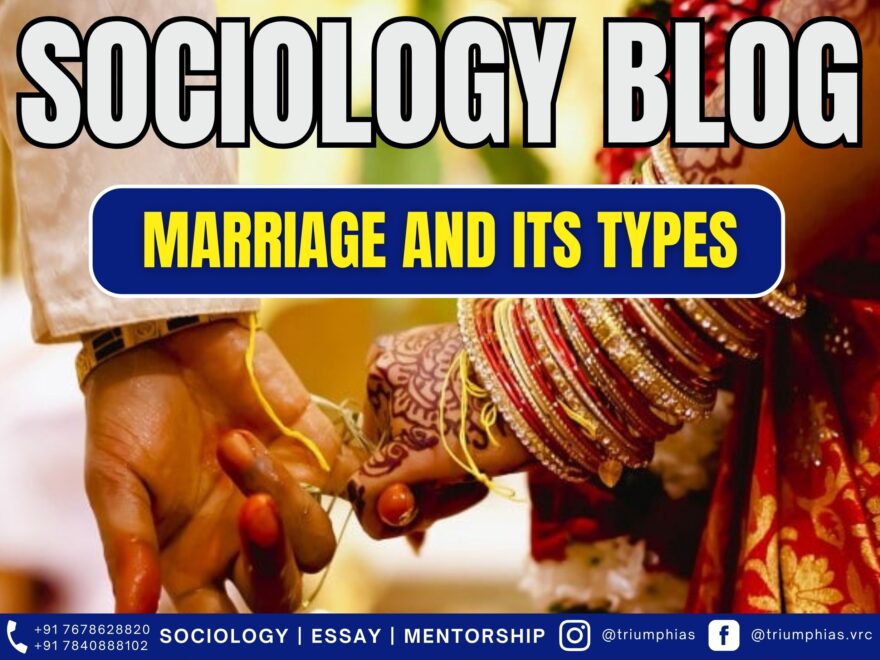Types of Marriage
(Relevant for Sociology : Paper-1)
Types of Marriage
Malinowski posits that marriage can be described as a formal agreement designed to facilitate the procreation and upbringing of children. It is a socially endorsed union where the couple’s sexual intimacy is tacitly acknowledged and validated. Different societies exhibit a multitude of customs and traditions related to marriage.
Types or forms of marriage:
Marriage is a widespread social institution that can be observed in every society and throughout different stages of development. While the specific types or structures of marriage may differ across societies, the fundamental concept remains largely consistent. It can be categorized into three main types: monogamy, polygamy, and group marriage.
-
Monogamy:
Monogamy, an esteemed and prevalent form of marriage, is considered rational and ideal. It can be observed across all civilized societies. Monogamy entails the union of one man and one woman. There are two variations of monogamy: serial monogamy and non-serial monogamy.
(i) Serial Monogamy:
Serial monogamous marriage allows for the option of remarrying in the event of divorce or the death of a spouse. Despite remarrying, the individual continues to practice monogamy.
(ii) Non-serial Monogamy:
In non-serial monogamy, the concept of remarriage is not relevant for either partner involved. In this type of relationship, a person remains married to the same spouse throughout their lifetime.
-
Polygamy:
Polygamy refers to a form of marriage where multiple partners are involved. It permits either a man to marry multiple women or a woman to marry multiple men simultaneously. Polygamy can be classified into two categories: polygyny, where a man has multiple wives, and polyandry, where a woman has multiple husbands.
(a) Polygyny:
Polygyny is a form of marriage where a man simultaneously marries multiple wives. This practice was prevalent in numerous ancient civilizations, including the Hebrews, Assyrians, Babylonians, and Indians, among others. Currently, it is primarily observed among indigenous tribes, although it tends to be more prevalent among wealthier individuals. Polygyny is practiced by Eskimo tribes, Crow Indians, African Negroes, as well as the Naga, Gonds, and Baigas of India. It is worth noting that polygyny is also allowed within the Muslim community. This type of marriage can be categorized into two forms:
(i) Sororal Polygyny
Sororal polygyny is commonly referred to as a surrogate. The term “surrogate” originates from the Latin word “sorer,” which means sister. Consequently, it denotes a marital custom where a man marries his wife’s sisters either simultaneously or following the death of his wife.
(ii) Non-Sororal Polygyny:
Non-sororal polygyny is the opposite of sororal polygyny. In non-sororal polygyny, a man marries multiple women simultaneously who may or may not be sisters to each other.
(b) Polyandry:
Polyandry is an extremely uncommon form of marriage in modern times. In this type of union, a woman marries multiple men simultaneously. According to K.M. Kapadia, “Polyandry is a union where a woman has more than one husband at the same time, or where brothers share a wife or wives in common.” It is observed among various cultures, including the Tibetans, Marquesas Islanders of Polynesia, the Bahamas of Africa, and tribal communities in Samoa, among others. In India, tribes such as the Tiyan, Toda, Kota, Khasa, and Ladakhi Bota also practice polyandry. The Nairs of Kerala were known for their practice of polyandry in the past. Polyandry can be classified into two types:
(i) Fraternal Polyandry:
Fraternal or adelphic polyandry refers to the arrangement where multiple brothers collectively share one wife. An excellent illustration of fraternal polyandry is seen in Draupadi’s marriage to the Pandavas. The identification of the biological father is determined through specific rituals. This practice is predominantly found among the Todas.
(ii) Non-fraternal Polyandry:
This type of marriage is in contrast to fraternal polyandry. In this arrangement, the husbands of a woman are not necessarily brothers to each other. It is observed among the Nairs of Kerala, where the wife spends specific periods of time with each of her husbands. As long as a woman resides with one of her husbands, the others do not possess any rights or claims over her. This practice primarily emerges as a result of limited availability of women.
Cenogamy or Group Marriage:
Group marriage refers to the union of two or more women with two or more men, where each woman is married to every man within the specific group. Sociologists, such as Dr. Rivers, describe it as a form of sexual communism. This form of marriage is observed among certain tribal communities in Australia, India, Tibet, and Ceylon, who are believed to have practiced group marriage.
Related Blogs …
To master these intricacies and fare well in the Sociology Optional Syllabus, aspiring sociologists might benefit from guidance by the Best Sociology Optional Teacher and participation in the Best Sociology Optional Coaching. These avenues provide comprehensive assistance, ensuring a solid understanding of sociology’s diverse methodologies and techniques.
META TAGS:
marriage of types, monogamy, polygamy, polygyny, polyandry, group marriage, serial monogamy, non-serial monogamy, sororal polygyny, non-sororal polygyny, fraternal polyandry, non-fraternal polyandry, social institutions
Follow us :
🔎 https://www.instagram.com/triumphias
🔎https://www.youtube.com/c/TriumphIAS
https://t.me/VikashRanjanSociology
Find More Blogs…
| Compare and contrast Karl Marx’s and Max weber’s | Karl Marx- Historical Materialism |
| Position of Women In the Modern Indian Society | Sociology: Social system and pattern variables |
marriage types, monogamy, polygamy, polygyny, polyandry, group marriage, serial monogamy, non-serial monogamy, sororal polygyny, non-sororal polygyny, fraternal polyandry, non-fraternal polyandry, social institutions
#Sociologyforupsc #sociologyforupscinhindi #sociologyforupscgs1 #sociologyforupscprelims #sociologyforupscinenglish #sociologyforupscmainsinhindi #sociologyforupscoptionalinhindi #sociologyforupscmains #sociologyforupscplaylist #sociologyforupsclecture1 #sociologyforupsccse #sociologyforupscoptional #syllabusofsociologyforupscoptional #bestbookforsociologyforupsc #sociologyoptionalforupscanswerwriting #sociologyoptionalforupscanukumari #sociologyoptionalforupscabhijeet #sociologyoptionalforupscanalysis #sociologyoptionalforupscalllectures #sociologysyllabusforupscanalysis


